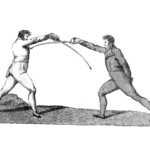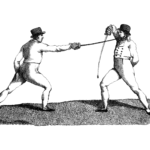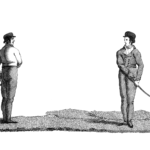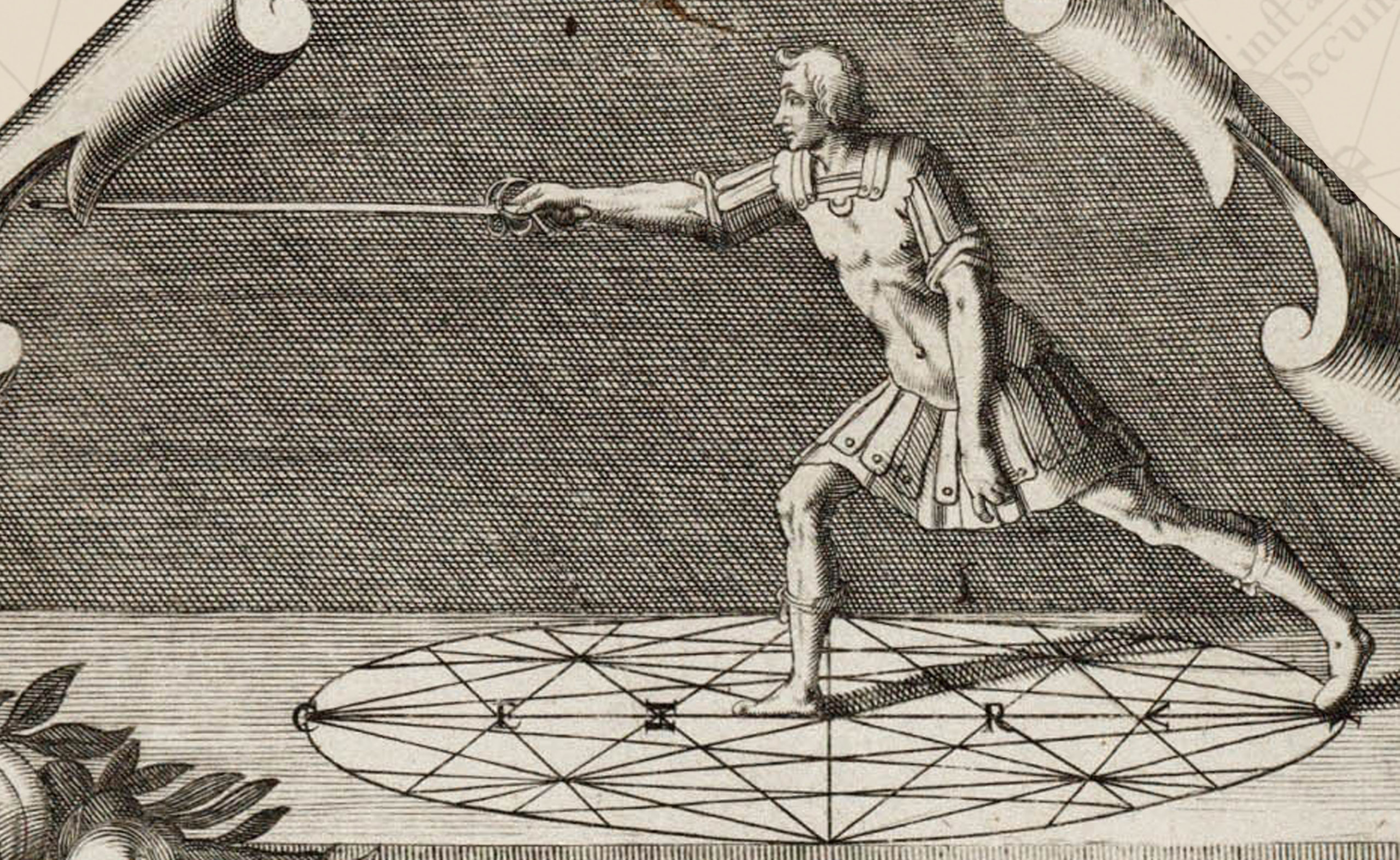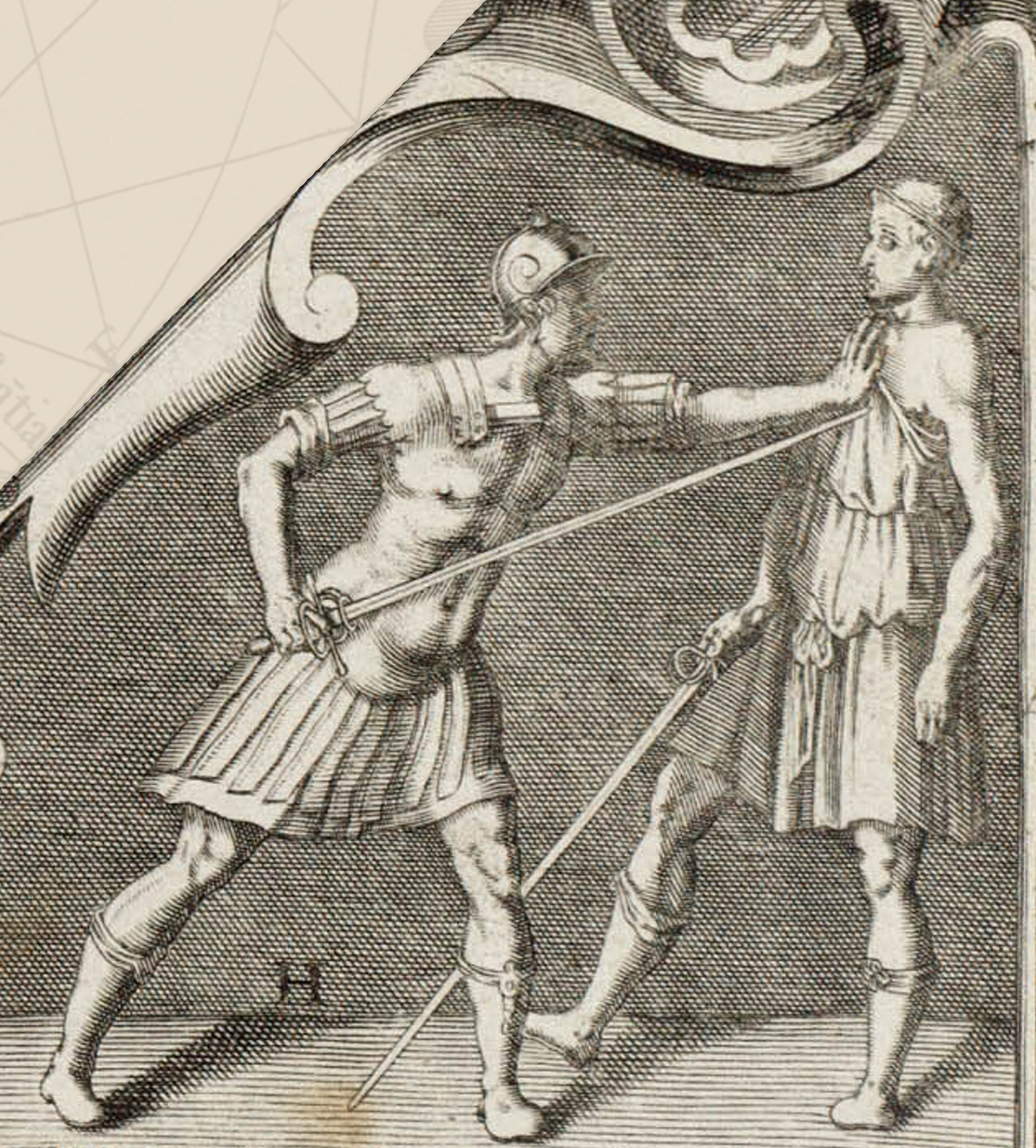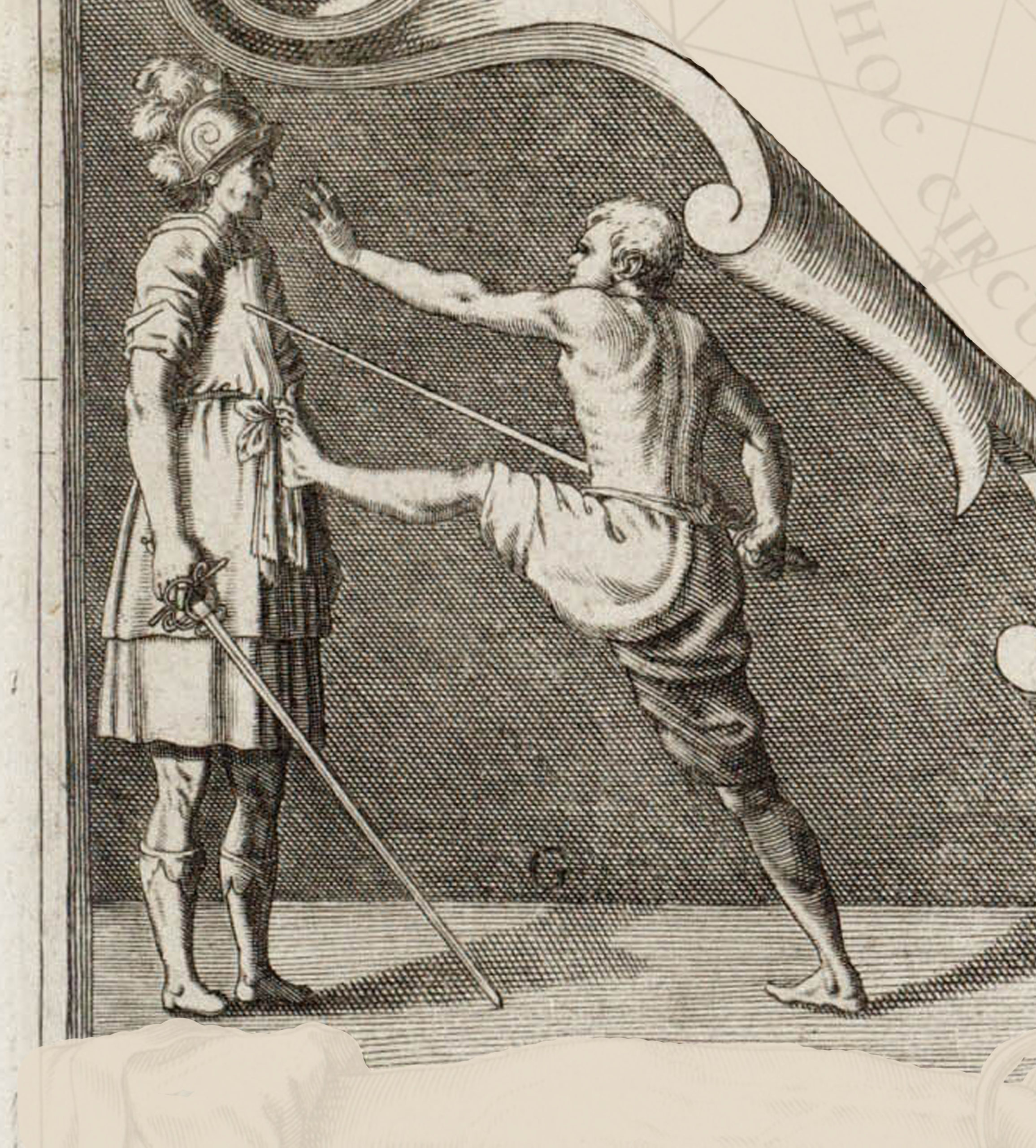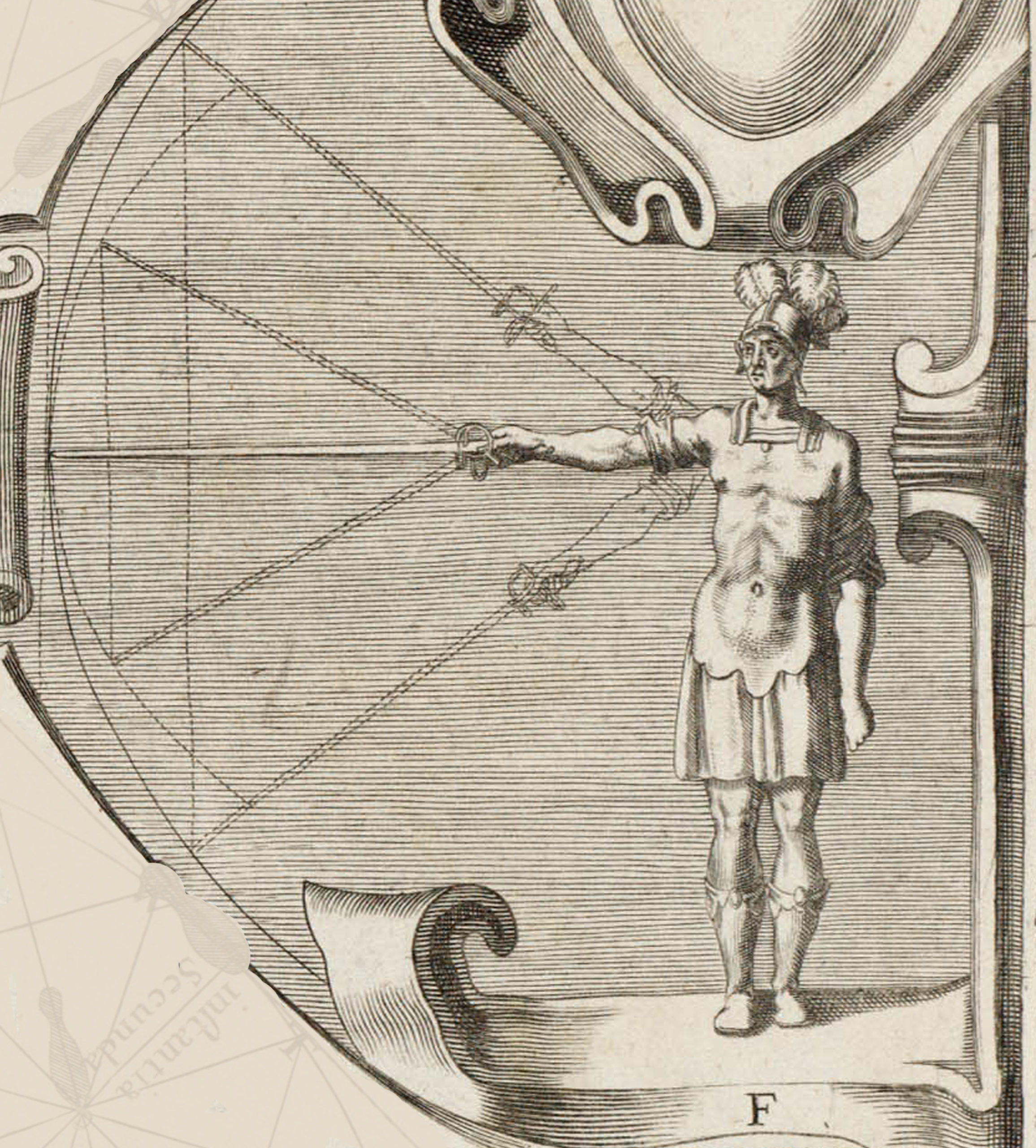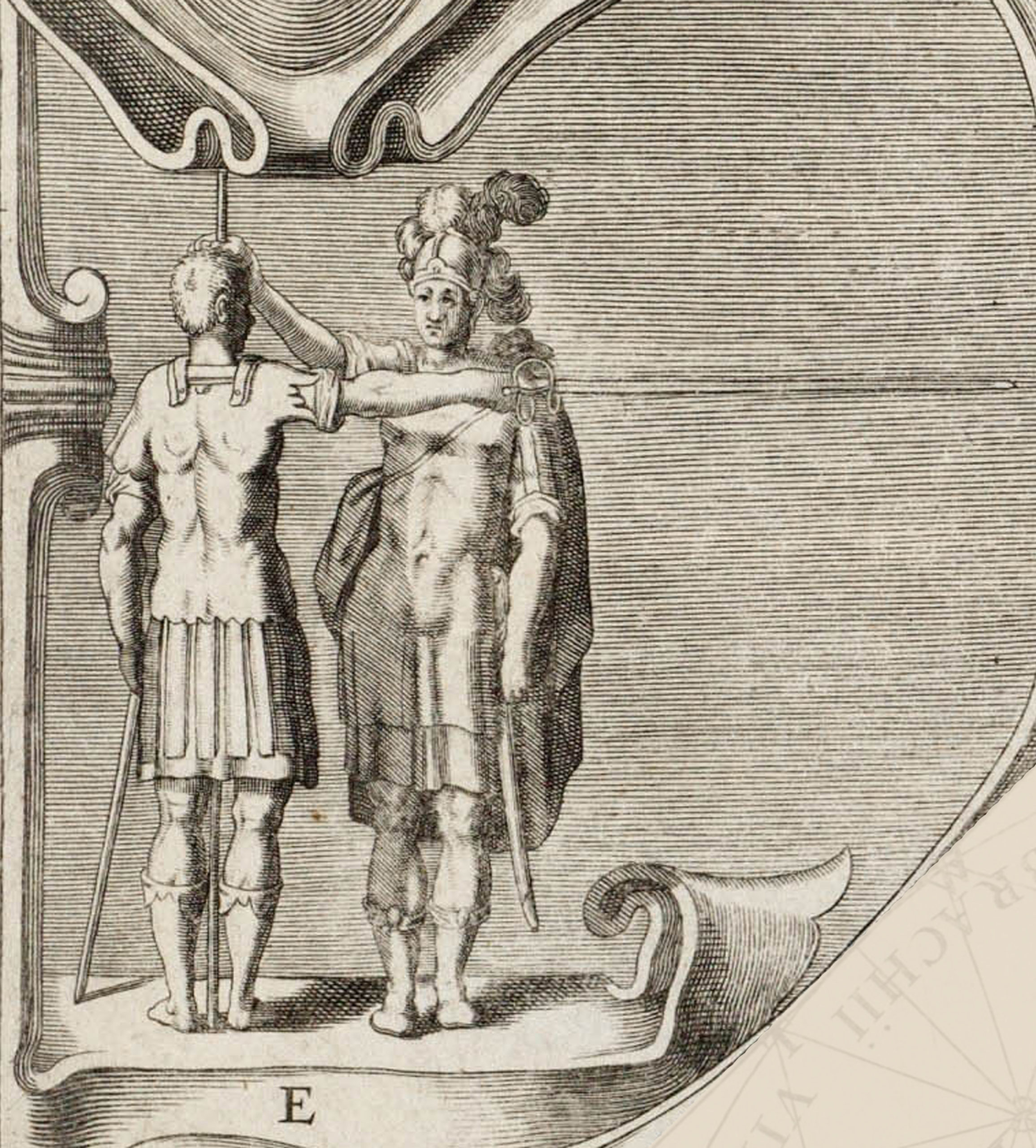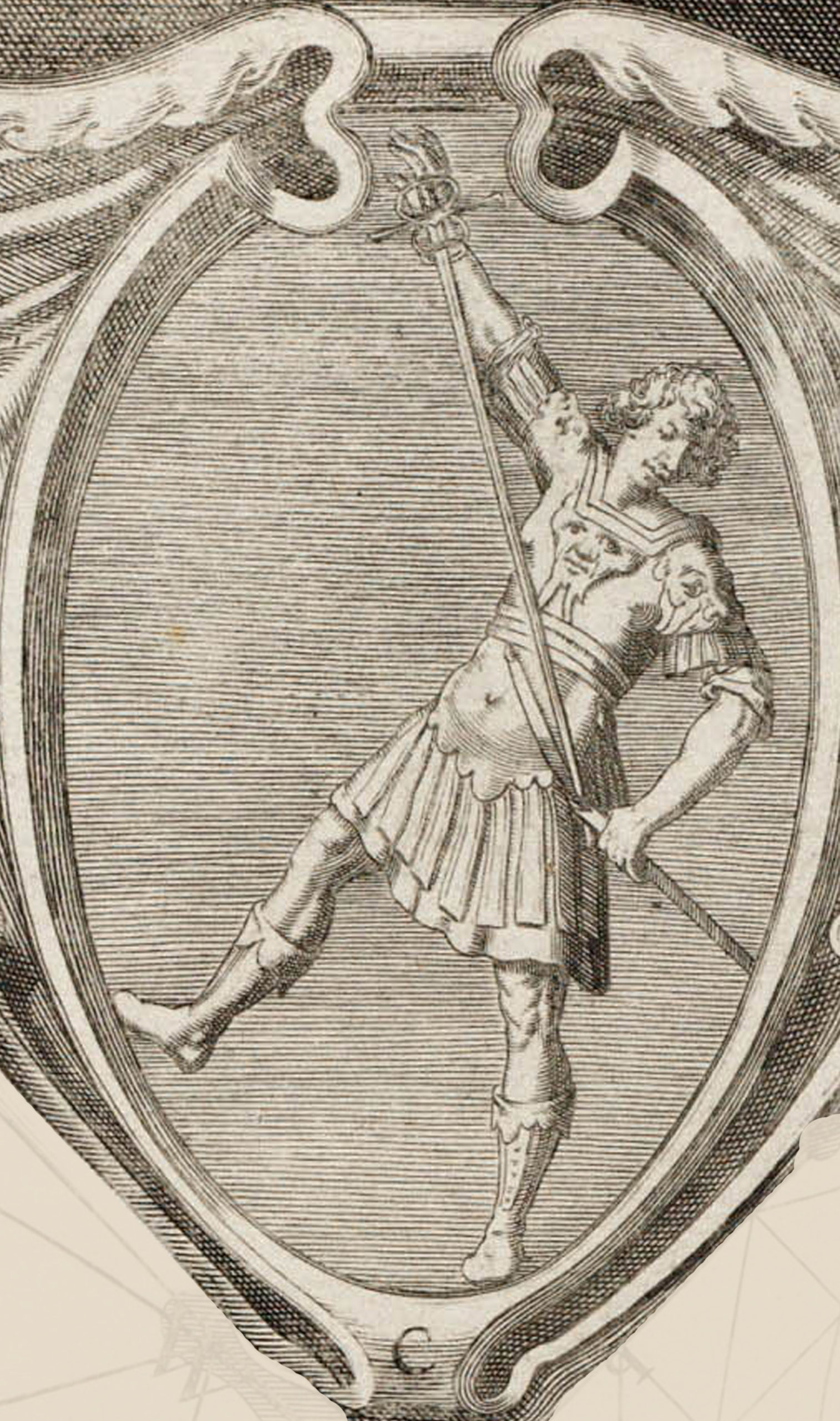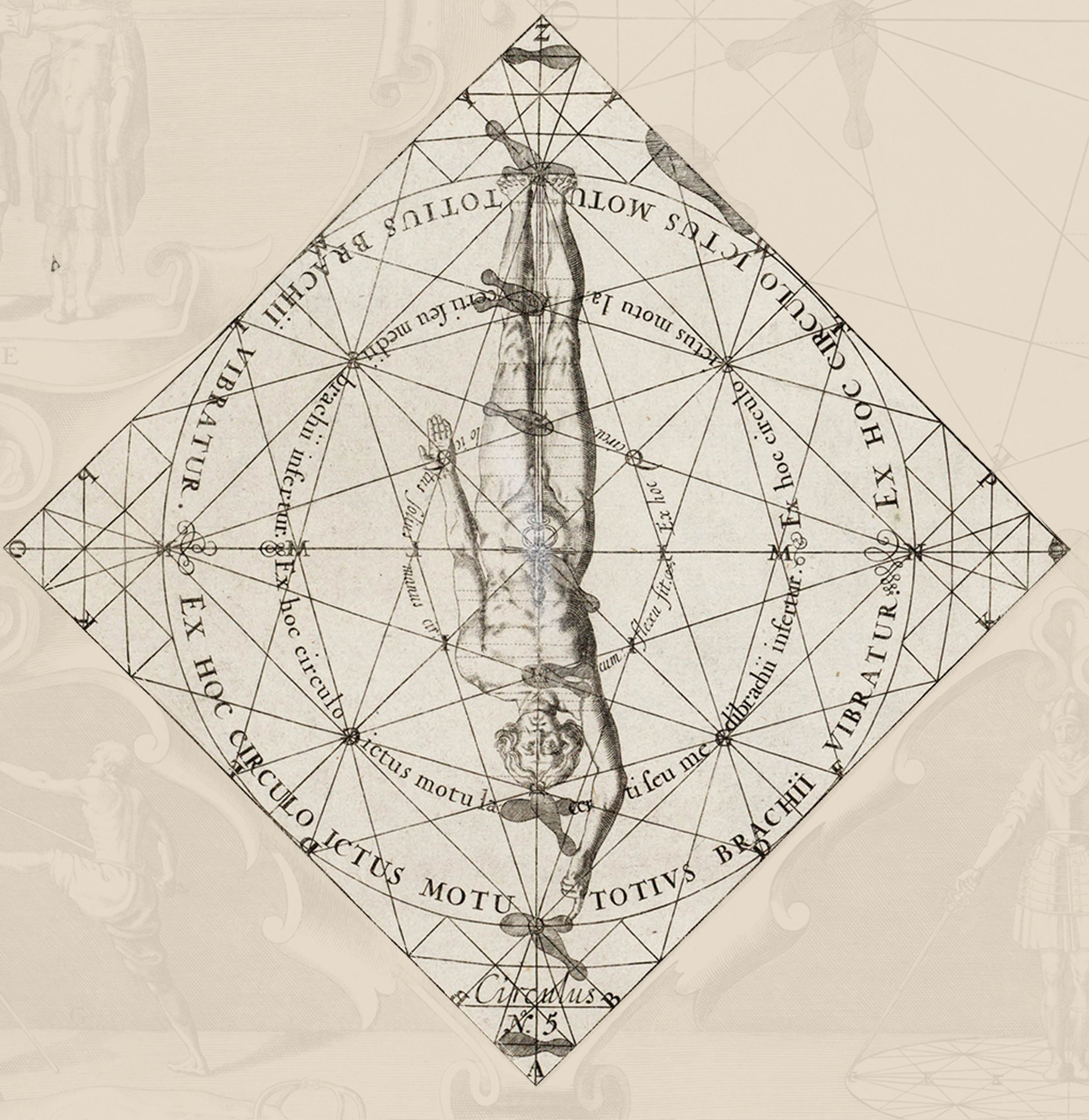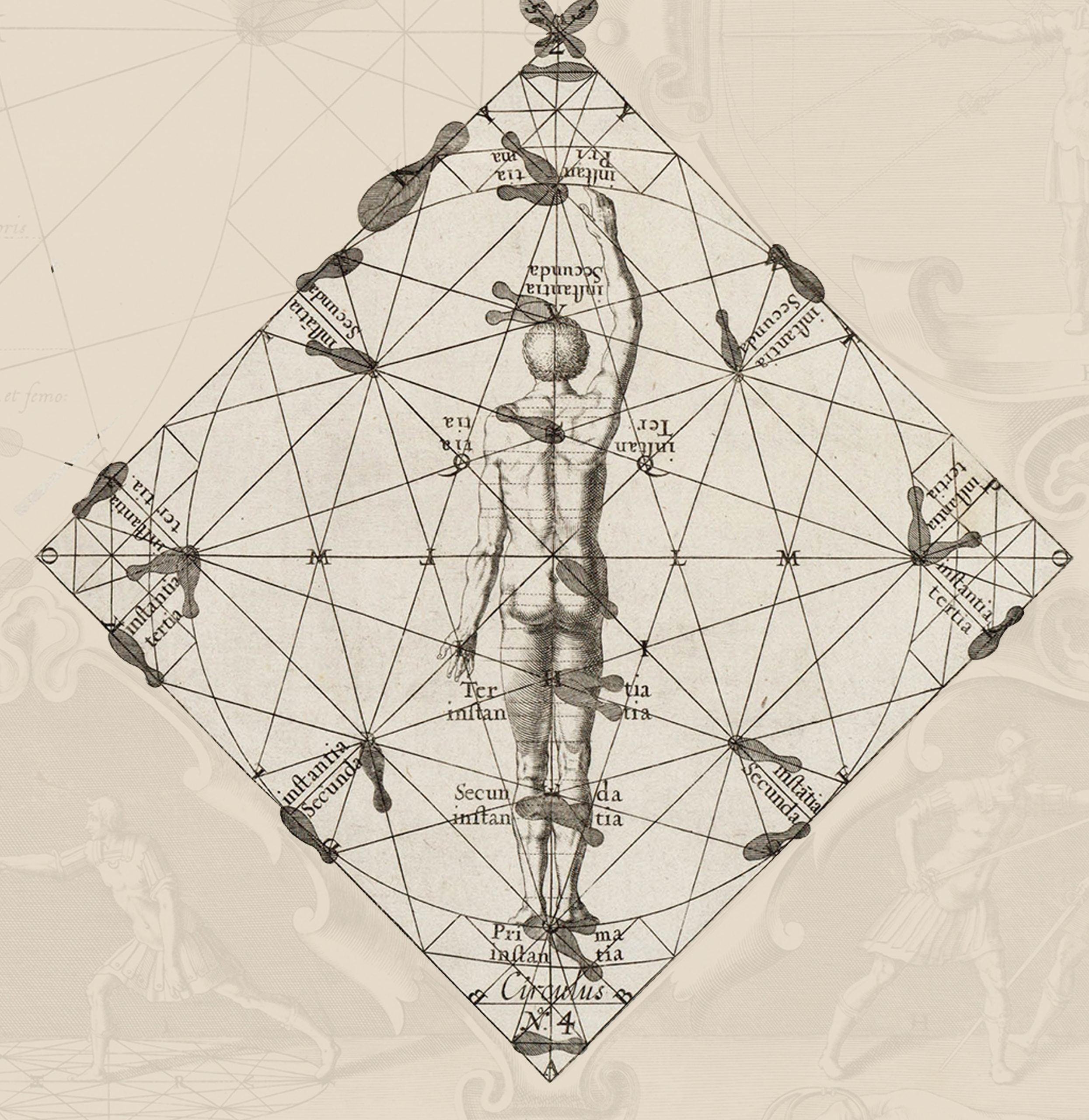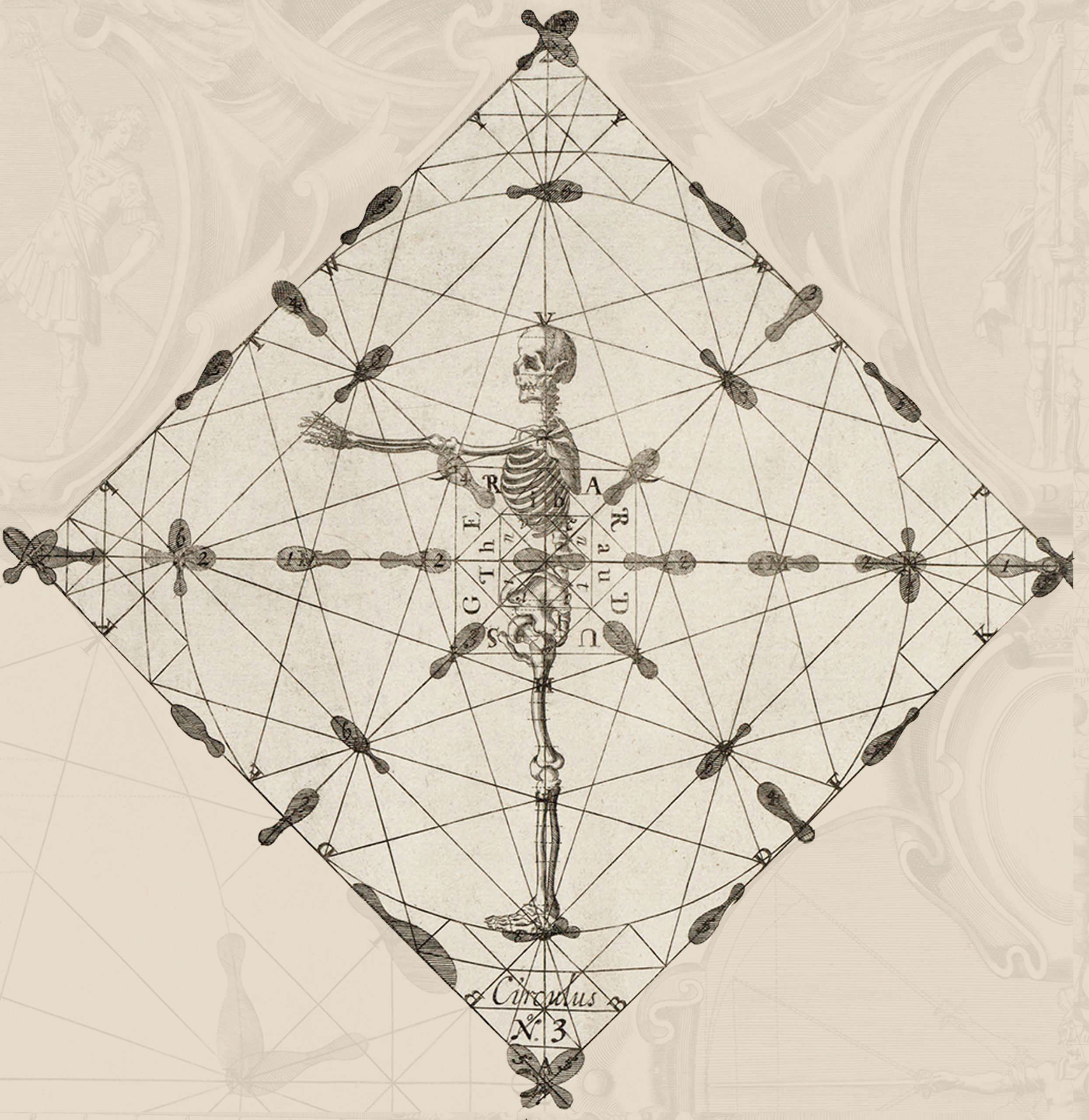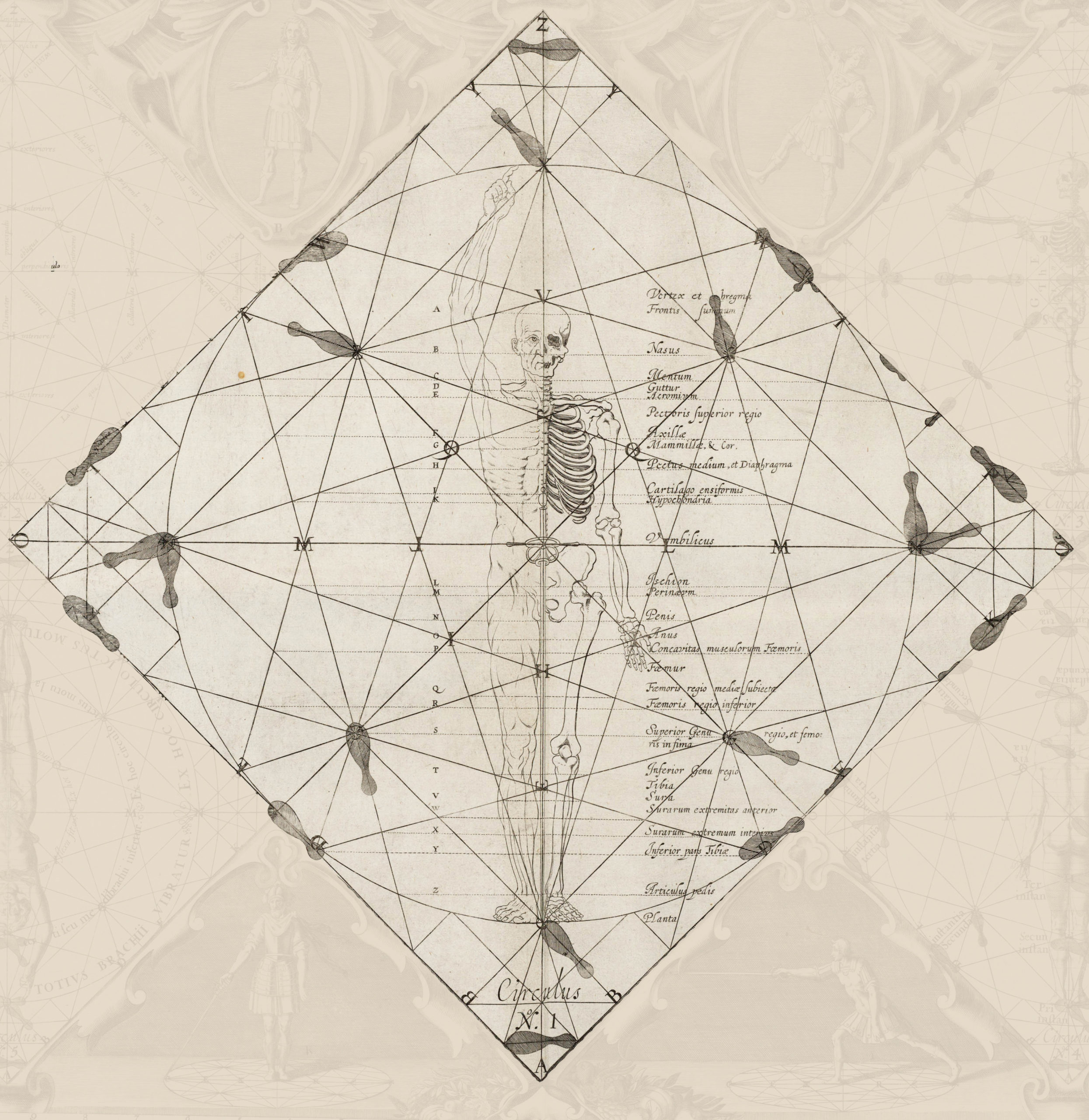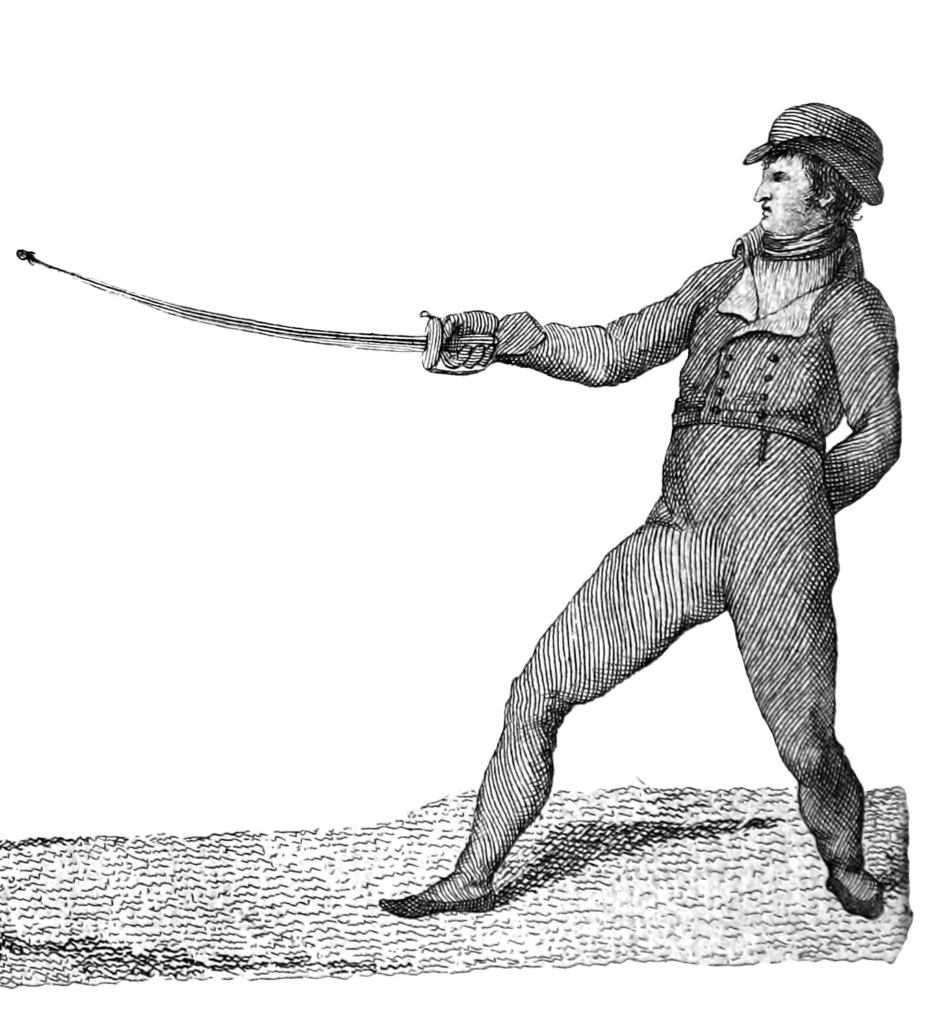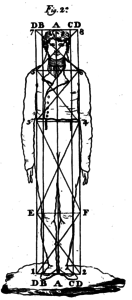390. What I have said up to now can be reduced to giving the rules and fundamentals of the skill, but I have presented them in portions so that each of their operations are isolated and, as they acquire their brightest aspects under a just and methodical gathering, I will try now to give my work this final hand. I will not be so bold as to offer here all of the combinations of shots and little things which form the body of this doctrine, as such an undertaking would not be appropriate to a purely elementary treatise. But, I will try to collect those which appear sufficient to serve as a basis for you to pass easily to any that the art may allow.
391. If, at the start of combat, they take the resolution of waiting, it must be assumed that the opposite may begin his battle in one of two ways, namely, taking a guard to wound by the sabre, or freeing, if you are waiting in any of the given ones. Assuming you took the common guard for defense, and that he took the one of fourth and the offensive stance. In this case, first, they must throw a thrust by the sabre without leaving the line. Second, leaving the line on the left side. Third, they can throw carrying to second. Fourth they can also, separating from the line on the right side, throw a fourth without engagement of weapons.
392. In the first of the cases proposed in the preceding paragraph, graduate balancing back and, without giving them time to recover, take the contrary weapon with your own from the place where the graduation ended and, passing through the removal of fourth, execute a thrust of second.
393. In the second case, make the same opposition as in the first with the difference of taking, at the same time, the right foot on its diagonal at least two thirds and inflict the same offense by the weapon that was attempted on your first recovery, turning for this to step deeply placing the right foot on the line that was previously considered the diameter before the opponent left it for their offense.
394.In the third case, turn the hand fully in third, picking up the arm a little, raising the elbow, and placing the guard to the height of the superior plane, covering the right vertical with low fifth, move square and, without allowing it to be restored, inflict a thrust by the sabre, or else a timed blow. But, if you leave the line on the left side at the time that you make the removal, instead of a thrust, cut vertically to the head or the arm, or forming below, a half cut to the neck.
395. In the final case, without taking the left foot out on the right diagonal as required by the enemy’s leaving of the line, make a removal of fourth and, without permitting the recovery, inflict a thrust by the sabre, directing it to the most uncovered point. Remove the right foot from the line of the diameter one third on the left side and advance with this the same amount. But, if the removal of fourth is done with restraint, leaving the line on the right side at the same time, you will have uncovered the point for a half reverse to the arm or neck, turning the hand in third to execute it immediately above the contrary guard or, instead, a vertical or diagonal to the head. Although the left side is equally uncovered, it should not be attacked as this cannot be done with the brevity that this response demands to so distant a point.
396. If the enemy, by virtue of the common guard in which you wait, takes (as has been said) that of fourth and the stance to attack, you must graduate immediately to deprive him of the generality of action that the common guard offers as has been seen in paragraph 391. Since, in this case there is only discretion to throw a thrust of fourth, either by the line or by leaving it on the left side. One way or another your offense allows by opposition the graduated timed blow (§ 378). But, if you want, you can also make a removal of fourth, replying by the sabre.
397. It is expressed in all of the preceding paragraphs that the enemy is able to attack when they take the guard of fourth and the offensive stance. But if the guard of fourth was not taken by the contrary, but by the defender, his only recourse is to attack by a free thrust of third, covered or uncovered. In the first case, making the removal, you can answer it to any of the points suggested in paragraph 385, being mindful in this of the appendix on provocations (§§ 298, 299, 300). If they attack uncovered, you will be able to receive it with a timed blow (§ 368). If not direct a blow of the counter edge against the wrist, standing firm, or with a leap back in your execution. If you do it with a leap, it removes all disposition to reply but, if it is on a firm foot, which he should remove under low fourth, extending the arm, this allows a reply with a thrust of second or fourth by the sabre. You can also free twice to execute a thrust of second or of fourth, in this case, receive it with a timed blow (§ 369) or with a removal to reply to any of the points suggested in paragraph 384, without forgetting the provocations cited. It is necessary to bear in mind that the timed blows can be used to oppose the wounds that have been executed by the sabre from the guard of fourth.
398. The enemy can take the guard of third and the offensive stance to attack by the same four methods as when they took it in fourth, namely, first, with a thrust of third by the sabre without leaving the line. Second, leaving the line on the left side. Third, they can throw by carrying to first. Fourth, also by separating the sabres and leaving the line on the left side, they can throw a thrust of third to the shoulder. To oppose the first and second cases, see paragraph 272, and to reply see 385 and 386 as a consequence of the two oppositions that are cited. To oppose the third, quickly form the parry of first (§ 278), or of low third as noted. To respond to the first, see paragraph 386, and to the second 385. To oppose the last case, form the removal of third of the first order moving on the left diagonal, and respond as explained in the last paragraph cited.
399. If the removal of third is made by subjecting the enemy’s weapon downward, leave the line on the left side at the same time to open them, uncovering the points to execute a half cut to the face over the guard of the other sabre or a vertical to the head or arm, leaping back in the execution. But if, before the enemy takes the determination to attack, by virtue of the guard of third and the offensive stance that has been explained, you take the precaution of graduating your own sabre, offering the point that they asked for even more, they will be limited by this operation, being unable to throw anything other than a thrust of third by the line, or leaving it. Either way, you can oppose with the timed blow of the same name, or make a removal of third or of first, replying (§§ 385 and 386).
400. When, in virtue of the common guard, the contrary takes the attacking stance and does not allow you to take the guard of third as explained, but waits for you in it, there is no other recourse but to attack with a free thrust of fourth, because anything else the enemy will determine to throw from this position, by virtue of the defensive measure, with the evil consequence of finding yourself made the sheath of his opponent’s sabre. The removal of fourth will be the opposition to the stated thrust, as occurs in paragraph 384, to know how to respond to it. But, if you notice the shot in advance, receive him with a timed blow (§ 369).
401. If the combatants have asserted the common guard, the enemy taking the attacking stance and the guard of sixth to attack on it, they will achieve it by throwing the thrust from paragraph 278 or of third by the sabre. To remove the first, see the oppositions in the same paragraph, and to respond, those of 385 and 384, or receive it with a timed blow of first with the hand in fourth, but if to make the remove of first (§ 278) to his thrust of paragraph 278 cited, departing from the line on the right side, you can answer with a vertical or diagonal cut to the arm or the head. If they execute the third, see paragraph 272 to oppose it, and to respond, 385. If firm in the stated stances, and the one who defends takes the guard of sixth that the contrary wanted, you put him with this, in the strait of giving first to the battle a free thrust of second. In this case, you may receive it with a timed blow (§ 371) or with a removal to answer any of the points suggested in paragraph 387.
402. Suppose that the two combatants have, one in the attacking stance and the other waiting, their sabres in the common guard. The offender takes the guard of fifth to attack on it with a thrust from paragraph 277 or that of 288. To oppose the first, see the same paragraph and to respond on the removal, see the points that are uncovered by the one who throws the thrust of second (§ 387). If he executes the last offense, taking the same arrangement as that of paragraph 271, to respond see 384. You can remove the first offense (§ 277) very well with low fourth (see the note of paragraph 278) and, in this case, the replies are the last that I just suggested (§ 384).
403. In many places in this treatise, it is warned not to begin any part of those that compose a combat with out giving firstly a thrust, so that from the points that are uncovered on its removal, you can choose purposefully to repeat a cut. Since the movement of these is larger than of the thrusts and much further to reach the enemy from the measure of common defense, the contrary could very well, using this opportunity, go out in the middle of the action to receive their opposite with a timed thrust or cut. Supposing my reader finds himself needing to resist an enemy who wants to execute a diagonal or vertical cut to the head, forewarned of the given rule to begin the battle, you will first throw a thrust of third, to give fact for the removal of the two offenses, the present object being to know where you must respond to the contrary from the removal of high fourth from with which his cut is opposed, as occurs in paragraph 388 where you will find everything necessary for its effect. If instead of making the removal, he chooses to inflict a blow of time, see paragraph 374.
404. The enemy may attempt to inflict a diagonal or vertical reverse to your head. In this case, make the removal of high third. You will reply to any of the points that I have suggested in paragraph 389. If you choose to offend before he completes his reverse, execute the timed blow from paragraph 375.
405. Note that any offense that the enemy attempts to execute to any part of the body should be repaired with any of the six removals on which the above replies have been explained, whether they are formed of the first or second order. For example: suppose that the reply was not achieved in the first thrust of fourth that the enemy executed, having been repaired and that they repeat one of third to be removed with third of the second order. In this case, the response will be on the removal of third to any of the points explained in paragraph 385. Example two: if the enemy, has thrown a thrust to the outside, either of second or third and he is not answered on the removal and he repeats, for the second shot, a diagonal cut to the flank, it must be repaired with first. On this wound, the points uncovered on the contrary can be attacked with a reply which are the same as if they had thrown a thrust of first (§ 336, and so with the others. This rule allows as an exception, that if the enemy executes any of the uncovered shots which is accompanied by a leap back, by virtue of leaving the measure of common defense at the same time, no response can be carried out for lack of reach. In the event of following him with some offense, it will be the beginning of the battle, not a response.
406. I must also warn my reader, that I leave more of the answers settled, and to be executed in the points that the attacker necessarily uncovers, keeping in mind what is contained in the seventh part of this treatise, to oppose your enemy in any time of the fight, with any of the conclusions, blows of the hand, or in time, which are explained there with greatest clarity, substituting with these offenses, the replies that you should inflict to your contrary on the removals.

